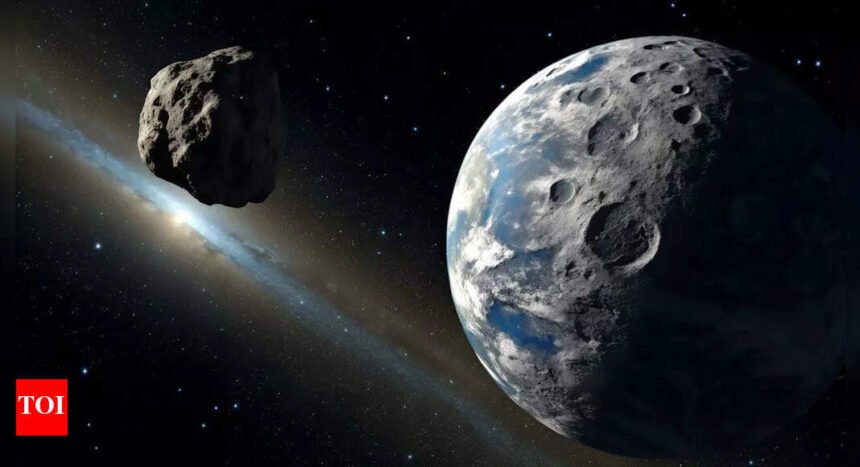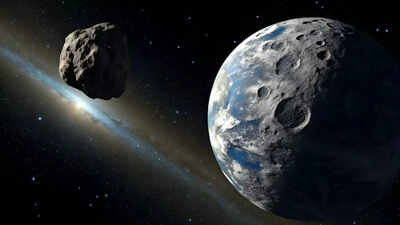The growing precision of space observation has placed planetary defence at the centre of contemporary astrophysics. Among emerging candidates for mitigation planning, asteroid 2024 YR4 has prompted renewed attention to the role of nuclear disruption as a viable last-resort option against potential celestial collisions. Discovered in December 2024, this near-Earth asteroid follows an orbit that occasionally brings it within the Earth–Moon system. Though the risk of an Earth strike has been excluded, ongoing analyses reveal a small but measurable probability of a lunar impact in 2032. Current studies now evaluate how nuclear-based intervention could prevent secondary hazards, including debris clouds that threaten satellites and human spaceflight.
Nuclear Defence and the Case for Asteroid 2024 YR4
A study by arXiv, titled Space Mission Options for Reconnaissance and Mitigation of Asteroid 2024 YR4 assessed mission pathways incorporating kinetic and nuclear disruption strategies. While traditional deflection approaches rely on imparting a minor change in velocity through impactors, nuclear disruption involves delivering a substantially greater impulse capable of fragmenting or redirecting an object entirely. For 2024 YR4, which measures approximately 60 ± 7 metres across according to James Webb Space Telescope (JWST) observations, the energy required to achieve orbital alteration via kinetic means would exceed the practical capabilities of existing spacecraft. Nuclear intervention, by contrast, provides a scalable mechanism suited to asteroids of this size and composition.The study outlines viable nuclear mission windows between late 2029 and late 2031, leaving a few years for spacecraft development if initiated promptly. These scenarios consider both rendezvous and high-speed intercept modes, each involving a nuclear explosive device detonated at a calibrated distance above the asteroid’s surface. Such timing ensures maximum momentum transfer while minimising the generation of hazardous debris. Even if a lunar collision is later ruled out, researchers argue that a demonstration mission targeting 2024 YR4 could advance the global readiness for planetary defence.
Physics of Nuclear Standoff Detonation
In the nuclear standoff model, an explosive charge is detonated at a controlled height above the asteroid’s surface, known as the height of burst. The emitted radiation vaporises a thin layer of the asteroid’s outer material, which expands rapidly and propels the remaining mass in the opposite direction. This recoil imparts a measurable change in velocity, ΔV, without requiring direct contact. The method allows fine-tuning of energy yield and standoff distance, enabling mission engineers to balance disruption efficiency against fragmentation risk.The advantage of the standoff technique lies in its flexibility and reduced technical complexity. It can be implemented during either a rendezvous or a high-speed intercept, depending on time constraints and available propulsion technologies. Unlike buried or contact detonations, which require physical anchoring or penetration mechanisms, standoff detonation avoids the challenge of surface coupling on irregularly shaped asteroids. Researchers at NASA’s Jet Propulsion Laboratory and contributing institutions note that this makes it particularly suitable for rapid-response missions where preparation time is limited.
Mitigating Secondary Risks from Lunar Impact
While nuclear disruption targets the asteroid directly, the motivation for such measures arises from the potential side effects of a lunar impact. NASA’s 2025 assessment revised 2024 YR4’s impact probability with the Moon to approximately 3.8 percent. If such an event were to occur, modelling suggests a transient but severe increase in micrometeoroid flux in low Earth orbit, potentially elevating debris levels by up to a thousandfold for several days. This could threaten operational satellites, damage space station components, and complicate ongoing lunar exploration missions.Mitigation through nuclear disruption would aim to prevent or substantially reduce this cascade effect by fragmenting the asteroid into smaller bodies that either miss the Moon or disperse across wider orbits. Although the strategy introduces its own challenges, particularly the management of post-disruption fragments, its proponents argue that controlled fragmentation is preferable to a single high-energy impact on the lunar surface. The arXiv analysis emphasises that careful adjustment of detonation parameters could ensure debris dispersal trajectories that minimise subsequent encounters with Earth’s orbital environment.
Engineering Readiness and Policy Framework
The implementation of nuclear mitigation missions requires more than propulsion and guidance technology; it demands a coordinated policy structure encompassing international oversight, safety protocols, and dual-use considerations. Both the NASA Planetary Defense Strategy and Action Plan and the White House National Preparedness Strategy for Near-Earth Object Hazards identify nuclear disruption capability as a contingency rather than a default measure. Its activation depends on credible threat verification, cooperative authorisation, and compliance with existing space treaties that restrict the use of nuclear devices beyond Earth’s atmosphere.Technologically, such missions would rely on propulsion systems already under development for deep-space exploration, including high-efficiency solar-electric engines. Advances in autonomous navigation and radiation shielding have further reduced the engineering barriers that historically limited nuclear payload missions. If approved, a 2029–2031 launch window for a nuclear disruption test involving 2024 YR4 would demonstrate operational readiness while yielding invaluable data on blast coupling, ejecta dynamics, and asteroid surface composition.
From Observation to Intervention
The significance of asteroid 2024 YR4 extends beyond its immediate trajectory. Its moderate size and periodic approach make it an ideal test subject for integrated reconnaissance and mitigation efforts. A JWST observation campaign scheduled through 2026 and subsequent ground-based tracking in 2028 will refine its orbit, reducing uncertainties before final mission commitments are made. Should those data reaffirm even a marginal lunar impact probability, early-deployed nuclear disruption plans could proceed within the projected timeline.Researchers stress that early detection and flexible planning remain central to any viable planetary defence strategy. Conditional mission architectures, designed to pivot between reconnaissance, deflection, or disruption, allow agencies to act without committing prematurely to a single course. For 2024 YR4, such modularity ensures preparedness whether or not the asteroid ultimately poses a lunar threat. The study of its potential mitigation exemplifies how nuclear technologies, once confined to terrestrial applications, are now being reconsidered as tools for safeguarding the Earth–Moon system itself.Also Read | What IS 3I/ATLAS: The Comet that’s breaking all the solar system rules







